- Accueil
- Pages cachées
- 18 FEVRIER 2024 NEWS
18 FEVRIER 2024 NEWS
INSTITUT SUPERIEUR D'ANTHROPOLOGIE
INSTITUTE OF ANTHROPOLOGY
ONLINE COURSES / COURS A DISTANCE
INSCRIPTIONS OUVERTES
REGISTER NOW
ITALIE – 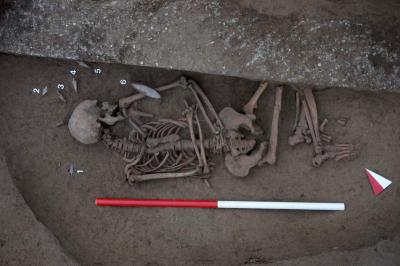 San Giorgio Bigarello - In the town of San Giorgio Bigarello, near the northern Italia city of Mantua, a large Copper Age necropolis dating back to about 5000 years ago has been discovered. The discovery of the large necropolis has proved to be a surprise both in terms of the quantity of excavated tombs, a total of 22, and the archaeological data that promise to be very valuable for researchers. The unexpected number of graves and the exquisitely crafted weapons discovered in some of them are likely to provide new insights into the prehistoric inhabitants of this region of northern Italy. Excavated in November 2023 and January-February 2024, the first isolated tombs were, in fact, only a small portion of a larger cemetery, the precise dimensions of which have undoubtedly been lost over the ages. A variety of flint weapons were found in many tombs, including expertly crafted daggers, flawless arrowheads, and other blades. Since excavations began again in January, 19 more graves have been discovered, supporting the archaeologists’ theories that this was a cemetery rather than a few haphazard burials. The 22 burials were discovered only 40 or so centimeters below the surface.
San Giorgio Bigarello - In the town of San Giorgio Bigarello, near the northern Italia city of Mantua, a large Copper Age necropolis dating back to about 5000 years ago has been discovered. The discovery of the large necropolis has proved to be a surprise both in terms of the quantity of excavated tombs, a total of 22, and the archaeological data that promise to be very valuable for researchers. The unexpected number of graves and the exquisitely crafted weapons discovered in some of them are likely to provide new insights into the prehistoric inhabitants of this region of northern Italy. Excavated in November 2023 and January-February 2024, the first isolated tombs were, in fact, only a small portion of a larger cemetery, the precise dimensions of which have undoubtedly been lost over the ages. A variety of flint weapons were found in many tombs, including expertly crafted daggers, flawless arrowheads, and other blades. Since excavations began again in January, 19 more graves have been discovered, supporting the archaeologists’ theories that this was a cemetery rather than a few haphazard burials. The 22 burials were discovered only 40 or so centimeters below the surface.
https://arkeonews.net/a-large-copper-age-necropolis-discovered-in-italian-town/
PEROU – 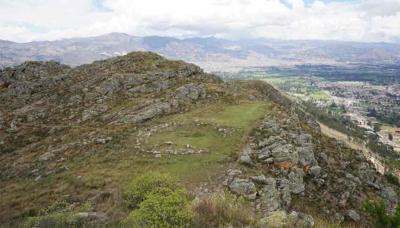
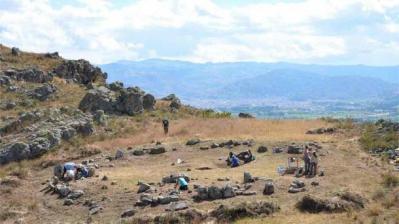 Callacpuma - Two anthropology professors from the University of Wyoming have discovered a prehistoric plaza high in the Andes, known as Callacpuma stone plaza, which was built nearly 5,000 years ago by ancient nomadic groups. The plaza, which is situated at the Callacpuma archaeological site in the Cajamarca Basin of northern Peru, was constructed using large megalithic stones that were arranged vertically, a technique not previously used in the Andes. This significant finding is a unique structure of a stone circle, where offerings were made to long-forgotten gods over several millennia at an elevation of more than 3,000 meters (9850 feet) above sea level. The project’s leaders, Associate Professor Jason Toohey, and Professor Melissa Murphy, have been researching this topic since the project began in 2015. Excavations for the plaza began in 2018. Their article, published in the journal Science Advances, provides new information about the northern Andes’ oldest known circular megalithic plaza. Radiocarbon dating indicates that it was built around 4,750 years ago, during the Late Preceramic Period, making it one of the Americas’ earliest examples of this type of architecture. Large megalithic stones are set in two concentric circles, each measuring 18 meters (60 feet) in diameter. This arrangement creates a ceremonial area that is full of unknown information from the time when hunter-gatherers in what is now Peru began to build more sophisticated societies. A prominent feature of the late preceramic era, the plaza represents a critical period of transition in South America when coastal fishing communities started to trade with emerging mountain agricultural societies. It is a prime example of monumental architecture built prior to the widespread adoption of agriculture and long-term settlements. Further discoveries at the site include unworked lapis lazuli gems, quartz crystals, and pieces of ceramic cups and bowls, all of which demonstrate the site’s significance and continued use even after the local populations had mastered pottery. Dated to the Layzón period (500–200 BC), recent artifacts made of soft kaolin clay indicate that the stone circle was visited on a regular basis until it was ceremoniously sealed during that same period for unidentified reasons. Semi-nomadic peoples’ building of these ritual sites reflects a change in their belief systems, which place more emphasis on group efforts and interregional cooperation.
Callacpuma - Two anthropology professors from the University of Wyoming have discovered a prehistoric plaza high in the Andes, known as Callacpuma stone plaza, which was built nearly 5,000 years ago by ancient nomadic groups. The plaza, which is situated at the Callacpuma archaeological site in the Cajamarca Basin of northern Peru, was constructed using large megalithic stones that were arranged vertically, a technique not previously used in the Andes. This significant finding is a unique structure of a stone circle, where offerings were made to long-forgotten gods over several millennia at an elevation of more than 3,000 meters (9850 feet) above sea level. The project’s leaders, Associate Professor Jason Toohey, and Professor Melissa Murphy, have been researching this topic since the project began in 2015. Excavations for the plaza began in 2018. Their article, published in the journal Science Advances, provides new information about the northern Andes’ oldest known circular megalithic plaza. Radiocarbon dating indicates that it was built around 4,750 years ago, during the Late Preceramic Period, making it one of the Americas’ earliest examples of this type of architecture. Large megalithic stones are set in two concentric circles, each measuring 18 meters (60 feet) in diameter. This arrangement creates a ceremonial area that is full of unknown information from the time when hunter-gatherers in what is now Peru began to build more sophisticated societies. A prominent feature of the late preceramic era, the plaza represents a critical period of transition in South America when coastal fishing communities started to trade with emerging mountain agricultural societies. It is a prime example of monumental architecture built prior to the widespread adoption of agriculture and long-term settlements. Further discoveries at the site include unworked lapis lazuli gems, quartz crystals, and pieces of ceramic cups and bowls, all of which demonstrate the site’s significance and continued use even after the local populations had mastered pottery. Dated to the Layzón period (500–200 BC), recent artifacts made of soft kaolin clay indicate that the stone circle was visited on a regular basis until it was ceremoniously sealed during that same period for unidentified reasons. Semi-nomadic peoples’ building of these ritual sites reflects a change in their belief systems, which place more emphasis on group efforts and interregional cooperation.
https://arkeonews.net/4750-year-old-megalithic-stone-plaza-discovered-in-the-high-andes-of-peru/
CROATIE – 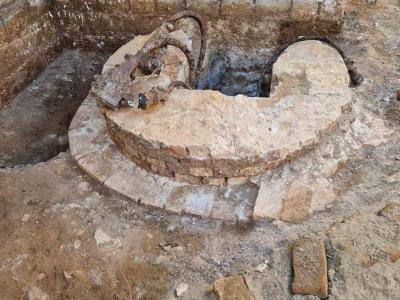 Dubrovnik - Archaeological discoveries were made while renovating the stone pavement surrounding the sizable Onofrio’s Fountain in the center of Dubrovnik’s historic district. These discoveries included the remnants of a sizable city cistern that is thought to have been there since the 14th century before the water supply system was built. One of the iconic landmarks of the city of Dubrovnik, the Great Onofrio’s Fountain was built in 1438 and brought water to the city from a series of springs 12 kilometers away. It was designed by the Italian Onofrio della Cava. Originally adorned with sculptures, the fountain was severely damaged in the 1667 earthquake, leaving only 16 carved masks with their mouths dribbling drinkable water into a drainage pool still visible. Although it was known from archival documents, the cistern was not documented during previous works at this location. Just 30 centimeters below the stone pavement, the vault of a large city cistern was found, reports HRT. “The first preserved information about the existence of a public cistern here dates from the late 14th century. It is also known that it came under the jurisdiction of the St. Clare monastery at the end of the 15th century and was even completely renovated on this occasion,” said Nela Kovačević Bokarica, archaeological supervisor. Until now, the city cistern, which preceded the Dubrovnik aqueduct, was only known from archival documents. It was a public cistern. The surface extends further south and east of this site, and it is presumed to be about 5 meters deep.
Dubrovnik - Archaeological discoveries were made while renovating the stone pavement surrounding the sizable Onofrio’s Fountain in the center of Dubrovnik’s historic district. These discoveries included the remnants of a sizable city cistern that is thought to have been there since the 14th century before the water supply system was built. One of the iconic landmarks of the city of Dubrovnik, the Great Onofrio’s Fountain was built in 1438 and brought water to the city from a series of springs 12 kilometers away. It was designed by the Italian Onofrio della Cava. Originally adorned with sculptures, the fountain was severely damaged in the 1667 earthquake, leaving only 16 carved masks with their mouths dribbling drinkable water into a drainage pool still visible. Although it was known from archival documents, the cistern was not documented during previous works at this location. Just 30 centimeters below the stone pavement, the vault of a large city cistern was found, reports HRT. “The first preserved information about the existence of a public cistern here dates from the late 14th century. It is also known that it came under the jurisdiction of the St. Clare monastery at the end of the 15th century and was even completely renovated on this occasion,” said Nela Kovačević Bokarica, archaeological supervisor. Until now, the city cistern, which preceded the Dubrovnik aqueduct, was only known from archival documents. It was a public cistern. The surface extends further south and east of this site, and it is presumed to be about 5 meters deep.
https://arkeonews.net/ancient-city-cistern-found-near-croatias-iconic-fountain/
ITALIE – 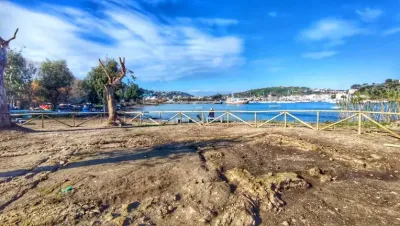 Bacoli- A massive Roman villa that stood 2,000 years ago and is thought to have ties to Roman scholar and military commander Pliny the Elder was recently discovered during municipal work by officials in Italy. The remnants of the villa, estimated to be from the 1st century AD, were found during an urban renewal project in Bacoli, located about 9 miles west of Naples in the Campania region, according to a press release from the Superintendency of Archeology. About 10 large rooms with different building phases, walking surfaces and traces of wall cladding have been identified. Researchers say the area where the Roman villa was unearthed was once an ancient settlement called Misenum, a significant Roman military port, and may have been witness to the violent cataclysm that destroyed Pompeii. A yet-to-be-verified hypothesis suggests that the villa was the residence of the prefect of the Roman Tyrrhenian Fleet. Researchers said this is because of its location near Punta Sarparella – a high point of land that juts out into the gulf offering views of the entire harbor. Researchers said this could have been the site where Pliny the Elder, who was in charge of the naval fleet at Misenum in 79 AD, witnessed the volcanic eruption. Perhaps this would have been the promontory from which Pliny the Elder, who held the position of Praefectus classis Misenensis, would have seen the eruption of Vesuvius, and then would have set sail for Stabiae, to help the inhabitants of the various coastal cities, threatened from the Vesuvian eruption," the city wrote the press release of the discovered Roman villa. Pliny the Elder left for a closer view of the eruption and to make possible rescues, but was killed in the event, along with thousands of others in Pompeii and its surrounding towns. In its press release, the Superintendency of Archeology, Fine Arts, and Landscape for the Naples Metropolitan Area said the discovery was of "exceptional significance" and noted that the perimeter of the rooms had been "well identified and fenced off" amid more extensive excavations.
Bacoli- A massive Roman villa that stood 2,000 years ago and is thought to have ties to Roman scholar and military commander Pliny the Elder was recently discovered during municipal work by officials in Italy. The remnants of the villa, estimated to be from the 1st century AD, were found during an urban renewal project in Bacoli, located about 9 miles west of Naples in the Campania region, according to a press release from the Superintendency of Archeology. About 10 large rooms with different building phases, walking surfaces and traces of wall cladding have been identified. Researchers say the area where the Roman villa was unearthed was once an ancient settlement called Misenum, a significant Roman military port, and may have been witness to the violent cataclysm that destroyed Pompeii. A yet-to-be-verified hypothesis suggests that the villa was the residence of the prefect of the Roman Tyrrhenian Fleet. Researchers said this is because of its location near Punta Sarparella – a high point of land that juts out into the gulf offering views of the entire harbor. Researchers said this could have been the site where Pliny the Elder, who was in charge of the naval fleet at Misenum in 79 AD, witnessed the volcanic eruption. Perhaps this would have been the promontory from which Pliny the Elder, who held the position of Praefectus classis Misenensis, would have seen the eruption of Vesuvius, and then would have set sail for Stabiae, to help the inhabitants of the various coastal cities, threatened from the Vesuvian eruption," the city wrote the press release of the discovered Roman villa. Pliny the Elder left for a closer view of the eruption and to make possible rescues, but was killed in the event, along with thousands of others in Pompeii and its surrounding towns. In its press release, the Superintendency of Archeology, Fine Arts, and Landscape for the Naples Metropolitan Area said the discovery was of "exceptional significance" and noted that the perimeter of the rooms had been "well identified and fenced off" amid more extensive excavations.
VIDEO = https://www.livenowfox.com/news/pliny-the-elder-roman-villa-mount-vesuvius-eruption-2024
CHYPRE - 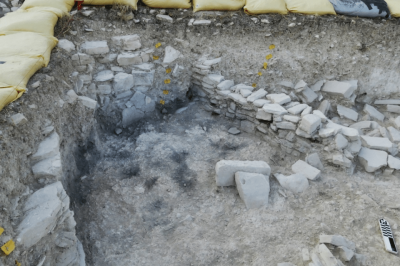 Kalavsos-Laroumena - An ancient room, among other ancient artefacts, was discovered during archaeological digs at the Kalavsos-Laroumena site near Larnaca. The findings were discovered during the digging of two trenches, both of which were 16 square metres in area. The archaeologists said they discovered “multiple large drystone walls”, which contained pottery. One of the walls was “filled with thick ash and charcoal deposits”, while the back wall of the room was positioned beneath the modern terrace wall.This, the archaeologists said, “supports the theory that the Laroumena hillside was originally terraced in the Middle Cypriot period for architectural structures and not for agriculture.”Additionally, they said one of the walls was “of unusual thickness” at 90 centimetres.Also found on the dig were spindle whorls, shell beads, a stone pendant, and some pottery. The archaeologists added that the “very large amount of worked stone flakes and blades” suggests that stone toolmaking was being carried out in the immediate vicinity of the site.
Kalavsos-Laroumena - An ancient room, among other ancient artefacts, was discovered during archaeological digs at the Kalavsos-Laroumena site near Larnaca. The findings were discovered during the digging of two trenches, both of which were 16 square metres in area. The archaeologists said they discovered “multiple large drystone walls”, which contained pottery. One of the walls was “filled with thick ash and charcoal deposits”, while the back wall of the room was positioned beneath the modern terrace wall.This, the archaeologists said, “supports the theory that the Laroumena hillside was originally terraced in the Middle Cypriot period for architectural structures and not for agriculture.”Additionally, they said one of the walls was “of unusual thickness” at 90 centimetres.Also found on the dig were spindle whorls, shell beads, a stone pendant, and some pottery. The archaeologists added that the “very large amount of worked stone flakes and blades” suggests that stone toolmaking was being carried out in the immediate vicinity of the site.
https://cyprus-mail.com/2024/02/15/kalavasos-archaeologists-discover-ancient-room/
ISRAEL –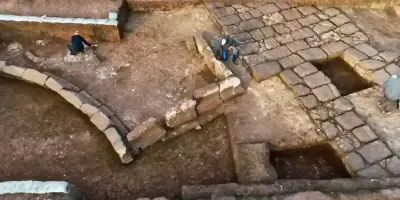 Tel Megiddo - Archaeologists have uncovered the remains of a massive 1,800-year-old Roman military base near Tel Megiddo in Israel. The camp, used by the VI Iron Legion for over 180 years, was discovered during a recent excavation by the Israel Antiquities Authority. The base measures an enormous 550 meters long by 350 meters wide and served as the permanent encampment for over 5,000 Roman soldiers from around 117-300 CE. Two main roads intersected at the headquarters in the center of the camp. The distances to cities across northern Israel were measured from this central point and marked by milestones along the Roman roads. Few architectural remains were preserved since building stones were removed over the centuries for reuse, but the excavation revealed parts of the main Via Pretoria road and a semicircular structure that was likely part of a monumental public building. A trove of artifacts was uncovered including coins, weapons, ceramics, and glass.
Tel Megiddo - Archaeologists have uncovered the remains of a massive 1,800-year-old Roman military base near Tel Megiddo in Israel. The camp, used by the VI Iron Legion for over 180 years, was discovered during a recent excavation by the Israel Antiquities Authority. The base measures an enormous 550 meters long by 350 meters wide and served as the permanent encampment for over 5,000 Roman soldiers from around 117-300 CE. Two main roads intersected at the headquarters in the center of the camp. The distances to cities across northern Israel were measured from this central point and marked by milestones along the Roman roads. Few architectural remains were preserved since building stones were removed over the centuries for reuse, but the excavation revealed parts of the main Via Pretoria road and a semicircular structure that was likely part of a monumental public building. A trove of artifacts was uncovered including coins, weapons, ceramics, and glass.
VIDEO = https://www.israelhayom.com/2024/02/15/1800-year-old-iron-legion-roman-legionary-base-exposed/
INDE - 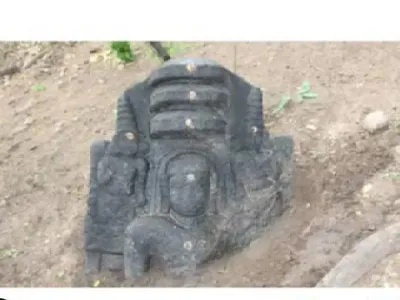 Manavarayanenda - group of archeology students led by a professor unearthed a 1000-year-old statue of the Mahavir idol during a field study carried out by them in the Manavarayanendal area near Thiruchuzhi in Tamil Nadu’s Virudhunagar district. The archeology students of a private college led by history professor Rajapandi found the statue of the 24th Tirthankar Mahavira in half-buried soil in the garden belonging to farmer Ilayaraja. The idol of Mahavir found at Manavarayanendal is seated on a throne with makartandus with the black stone masterpiece. Behind him was a halo called Prabhavali. At its top is a tiara design representing Chandradittha, Nithiyavinodam, and Kala Basana. It is reported that the period of this statue may be the 11th century. From Tirupullani to Madurai via Kamudi Thiruchuzhi, statues of Mahavira have been found in many places. Around the site of the sculpture, black and red pots of the Iron Age are found.
Manavarayanenda - group of archeology students led by a professor unearthed a 1000-year-old statue of the Mahavir idol during a field study carried out by them in the Manavarayanendal area near Thiruchuzhi in Tamil Nadu’s Virudhunagar district. The archeology students of a private college led by history professor Rajapandi found the statue of the 24th Tirthankar Mahavira in half-buried soil in the garden belonging to farmer Ilayaraja. The idol of Mahavir found at Manavarayanendal is seated on a throne with makartandus with the black stone masterpiece. Behind him was a halo called Prabhavali. At its top is a tiara design representing Chandradittha, Nithiyavinodam, and Kala Basana. It is reported that the period of this statue may be the 11th century. From Tirupullani to Madurai via Kamudi Thiruchuzhi, statues of Mahavira have been found in many places. Around the site of the sculpture, black and red pots of the Iron Age are found.
USA – 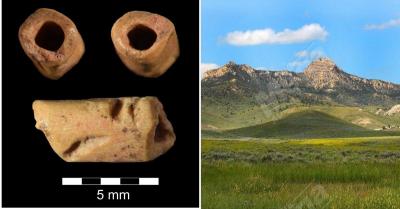 La Prele Mammoth - Archaeologists in Wyoming have discovered a tube-shaped object made from bone that is the oldest known bead found in the Americas. Knewz.com has learned that the 12,940-year-old bead represents an important marker indicating increased social and cultural complexity at the time. The bead is small, only about 7 mm in length, and features a hole that is just 1.6 mm wide, according to the research paper published in the peer-reviewed paper Scientific Reports. The bead features grooves on the outside of the object that scientists think were created by humans using either stone tools or teeth to form the object. The archaeologists, led by Todd Surovell, the Director of the George C. Frison Institute of Archaeology and Anthropology at the University of Wyoming, believe the beads would have been used to decorate the people’s bodies or clothing. While they did not speculate on the cultural significance of the bead, they did say it was probably used as a mark of identification among the people. The bead was found in a social area built around a hearth at the La Prele Mammoth site in Converse County, Wyoming and represents evidence of a bead-making tradition that has been discovered throughout Asia and Eurasia, but never this early in the Americas.;“We can now confidently say that this tradition extends back to the Early Paleoindian Period in the Rocky Mountain West,” the team wrote in the report. The tubular design of the bead is also important, as it is consistent with sites found in northeast Asia.“While it is tempting to suggest that this practice came across the Bering Land Bridge with the first migrants to the Americas, more material evidence would be needed to fill the large gap between Asian and North American examples,” the team wrote. They added that independent innovation of the bead is very much a possibility. The bone used to make the bead is believed to have come from a hare, and the scientists think it came from either a limb or digit (finger or toe) of the animal. They reached the conclusion by performing a procedure called “zooarchaeology by mass spectrometry (ZooMs),” which allows archaeologists to analyze the chemical composition of the bone. “This finding represents the first secure evidence for the use of hares during the Clovis period, which refers to a prehistoric era in North America,” wrote the University of Wyoming in a press release. While the archaeologists were confident the object was a bead, they did not rule out the possibility that carnivore consumption and digestion created the shape and hole. However, they said carnivores were not common at the site, and the bead was found alongside other cultural artifacts. The La Prele Mammoth archeology site is best known as the home of the remains of a Columbian mammoth that had either been killed or scavenged by the ancient residents. It has become a valuable resource because of the cultural objects that were left at the camp by the people who butchered the animal.
La Prele Mammoth - Archaeologists in Wyoming have discovered a tube-shaped object made from bone that is the oldest known bead found in the Americas. Knewz.com has learned that the 12,940-year-old bead represents an important marker indicating increased social and cultural complexity at the time. The bead is small, only about 7 mm in length, and features a hole that is just 1.6 mm wide, according to the research paper published in the peer-reviewed paper Scientific Reports. The bead features grooves on the outside of the object that scientists think were created by humans using either stone tools or teeth to form the object. The archaeologists, led by Todd Surovell, the Director of the George C. Frison Institute of Archaeology and Anthropology at the University of Wyoming, believe the beads would have been used to decorate the people’s bodies or clothing. While they did not speculate on the cultural significance of the bead, they did say it was probably used as a mark of identification among the people. The bead was found in a social area built around a hearth at the La Prele Mammoth site in Converse County, Wyoming and represents evidence of a bead-making tradition that has been discovered throughout Asia and Eurasia, but never this early in the Americas.;“We can now confidently say that this tradition extends back to the Early Paleoindian Period in the Rocky Mountain West,” the team wrote in the report. The tubular design of the bead is also important, as it is consistent with sites found in northeast Asia.“While it is tempting to suggest that this practice came across the Bering Land Bridge with the first migrants to the Americas, more material evidence would be needed to fill the large gap between Asian and North American examples,” the team wrote. They added that independent innovation of the bead is very much a possibility. The bone used to make the bead is believed to have come from a hare, and the scientists think it came from either a limb or digit (finger or toe) of the animal. They reached the conclusion by performing a procedure called “zooarchaeology by mass spectrometry (ZooMs),” which allows archaeologists to analyze the chemical composition of the bone. “This finding represents the first secure evidence for the use of hares during the Clovis period, which refers to a prehistoric era in North America,” wrote the University of Wyoming in a press release. While the archaeologists were confident the object was a bead, they did not rule out the possibility that carnivore consumption and digestion created the shape and hole. However, they said carnivores were not common at the site, and the bead was found alongside other cultural artifacts. The La Prele Mammoth archeology site is best known as the home of the remains of a Columbian mammoth that had either been killed or scavenged by the ancient residents. It has become a valuable resource because of the cultural objects that were left at the camp by the people who butchered the animal.
https://knewz.com/oldest-bead-ever-found-in-americas-unearthed-in-wyoming/
CHINE – 
 Tarim Basin - In 1990, hundreds of mummified bodies were found buried in boats in an inhospitable desert area in the Xinjiang Uyghur Autonomous Region in northwest China. Known as the Tarim Basin mummies they have now been genetically examined and scientists have narrowed down the origins of the mysterious mummies. The results are quite surprising. The mummies’ bodies and clothing are strikingly intact despite being up to 4,000 years old, having been discovered in the Tarim Basin in Xinjiang. Their facial features and hair color are visible, having been naturally preserved by the dry desert air. The mummies were discovered buried in boat-shaped coffins which were covered with cow hides. Beside them were signs of a farming society: food items like wheat, barley, and cheese, as well as livestock like sheep, goats, and cattle. They had the appearance of strangers from a foreign land because they were tall, had wool felt hats and leather booties on, and some of them had fair hair. However, genomes of 13 remarkably preserved 4,000-year-old mummies weren’t migrants who brought technology from the West, as previously supposed. A study of the mummies’ DNA finds that they were locals with deep roots in the area. In a study in the Nature Journal, researchers analyzed the genetic data gathered from mummies. They date back to 2,100 to 1,700 BCE and have revealed where the people came from. They appear to be relics of an ancient population that disappeared in Eurasia after the last ice age—one that was ancestral to Indigenous peoples living in Siberia and the Americas today. Individuals 400 kilometers apart at opposite ends of the Tarim Basin had DNA that was as similar as siblings. Even though the mummies were locals who had not intermarried with the migrant herders in nearby mountain valleys, they were not culturally isolated. By 4000 years ago, they had already embraced new ideas and cultures: they wore woven woolen clothing, constructed irrigation systems, grew nonnative wheat and millet, herded sheep and goats, and milked cattle to make cheese. Although previous work has shown that the mummies lived on the shores of an oasis in the desert, it’s still unclear why they were buried in boats covered in cattle hides with oars at their heads – a rare practice not found anywhere else in the region and perhaps best associated with the Vikings. According to the study, the group had been in the area for some time and had a distinct local ancestry, which refuted theories that they were herders from the southern Russian Black Sea region, Central Asians, or early farmers on the Iranian Plateau. Researchers also said it was possible for a population to be genetically isolated but also be culturally cosmopolitan. In addition to examining genomes sequenced from the remains of five individuals from the Dzungarian Basin further north in the Xinjiang Uyghur Autonomous Region of China, the researchers also examined genetic data from the oldest mummies from the Tarim Basin, which date from 3,700 to 4,100 years old. Dating back between 4,800 and 5,000 years ago, they are the oldest human remains found in the region.
Tarim Basin - In 1990, hundreds of mummified bodies were found buried in boats in an inhospitable desert area in the Xinjiang Uyghur Autonomous Region in northwest China. Known as the Tarim Basin mummies they have now been genetically examined and scientists have narrowed down the origins of the mysterious mummies. The results are quite surprising. The mummies’ bodies and clothing are strikingly intact despite being up to 4,000 years old, having been discovered in the Tarim Basin in Xinjiang. Their facial features and hair color are visible, having been naturally preserved by the dry desert air. The mummies were discovered buried in boat-shaped coffins which were covered with cow hides. Beside them were signs of a farming society: food items like wheat, barley, and cheese, as well as livestock like sheep, goats, and cattle. They had the appearance of strangers from a foreign land because they were tall, had wool felt hats and leather booties on, and some of them had fair hair. However, genomes of 13 remarkably preserved 4,000-year-old mummies weren’t migrants who brought technology from the West, as previously supposed. A study of the mummies’ DNA finds that they were locals with deep roots in the area. In a study in the Nature Journal, researchers analyzed the genetic data gathered from mummies. They date back to 2,100 to 1,700 BCE and have revealed where the people came from. They appear to be relics of an ancient population that disappeared in Eurasia after the last ice age—one that was ancestral to Indigenous peoples living in Siberia and the Americas today. Individuals 400 kilometers apart at opposite ends of the Tarim Basin had DNA that was as similar as siblings. Even though the mummies were locals who had not intermarried with the migrant herders in nearby mountain valleys, they were not culturally isolated. By 4000 years ago, they had already embraced new ideas and cultures: they wore woven woolen clothing, constructed irrigation systems, grew nonnative wheat and millet, herded sheep and goats, and milked cattle to make cheese. Although previous work has shown that the mummies lived on the shores of an oasis in the desert, it’s still unclear why they were buried in boats covered in cattle hides with oars at their heads – a rare practice not found anywhere else in the region and perhaps best associated with the Vikings. According to the study, the group had been in the area for some time and had a distinct local ancestry, which refuted theories that they were herders from the southern Russian Black Sea region, Central Asians, or early farmers on the Iranian Plateau. Researchers also said it was possible for a population to be genetically isolated but also be culturally cosmopolitan. In addition to examining genomes sequenced from the remains of five individuals from the Dzungarian Basin further north in the Xinjiang Uyghur Autonomous Region of China, the researchers also examined genetic data from the oldest mummies from the Tarim Basin, which date from 3,700 to 4,100 years old. Dating back between 4,800 and 5,000 years ago, they are the oldest human remains found in the region.
https://arkeonews.net/unexpected-origins-of-mysterious-mummies-buried-in-boats-in-a-chinese-desert/




